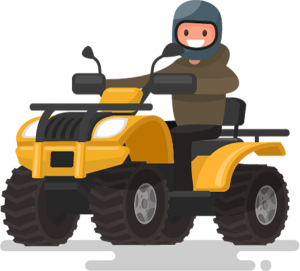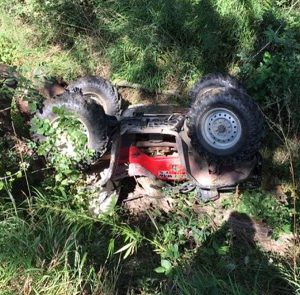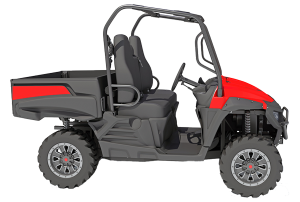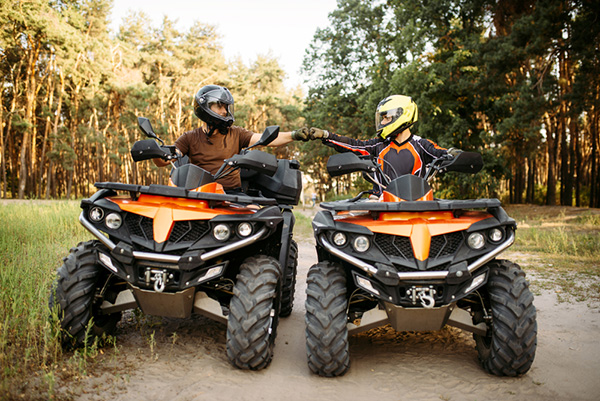MARCH 2024
 ATVs (All-Terrain Vehicles) and UTVs (Utility Task Vehicles) can be great tools for tasks on the farm or ranch, such as transportation, checking crops, livestock, hauling items around, snow plowing, and more. They can also be used for recreational purposes.
ATVs (All-Terrain Vehicles) and UTVs (Utility Task Vehicles) can be great tools for tasks on the farm or ranch, such as transportation, checking crops, livestock, hauling items around, snow plowing, and more. They can also be used for recreational purposes.
While enjoyable to drive and practical for work, it’s essential to remember that ATVs and UTVs are not toys. The thrill of riding can turn dangerous, even deadly, if not handled with caution.
David and Kenny

Farmer David Endorf from Nebraska shares first-hand accounts of potential dangers, like rollovers, when riding an off-road vehicle in the Telling the Story Project. “ ‘Without looking, I backed up and dropped the rear wheel off the side, and me and the 4-wheeler and sprayer all rolled down the bank.’ That bank has a 60-degree slope and a seven-foot drop.”
For farmer Kenny Patterson from Iowa, “When he and the ATV tipped left, he knew the outcome would be bad. He heard his thigh bone snap when 700 pounds of equipment rolled over him.”
David and Kenny were both lucky to survive. Their stories of nearly escaping death after being pinned under their rolled-over 4-wheelers stress the importance of always being prepared and practicing safety when operating off-road vehicles like ATVs or UTVs.

Big and heavy machines with high-stakes
Weighing between 600-2000 pounds, ATV/UTVs are heavy, large, and powerful machines. With a high center of gravity they can tip easily, throw riders off, or even roll over on top of riders. Resulting injuries can include broken bones, sprains, strains, and head and spinal cord injuries, with a large percentage of ATV/UTV-associated deaths related to head injuries.
Each year, the U.S. sees over 100,000 ATV/UTV-related emergency room visits and approximately 650 deaths, with children accounting for up to half of these incidents.
Source: CPSC.gov
These incidents often happen more frequently with inexperienced ATV/UTV drivers. This is because they may lack the necessary skills, education, and experience to operate these types of vehicles.
There are ways to stay safe and have fun at the same time. Learning safety practices and getting education and training on properly operating an ATV or UTV can help prevent serious injuries and make it a safer experience for riders.
 Rev up your safety game with these ATV/UTV safety strategies:
Rev up your safety game with these ATV/UTV safety strategies:
Before hitting the trails, gear up with safety protection.
- Always wear a helmet and protective gear like goggles, gloves, long pants, a long-sleeved shirt, and sturdy boots.
- For UTVs, always fasten your seatbelt, close the doors or fasten the gates and keep all parts of your body inside the UTV.
- Be safe in the sun by applying SPF 30 sunscreen and reapplying at least every two hours.
When selecting an ATV/UTV, it's important to consider both skill level and size.
- Children under 16 should never operate an adult-size ATV or any UTV.
- While a child may be the recommended age to ride a specific-sized ATV, not all children have the strength, skills, or judgment to operate an ATV properly and safely.
To ensure a safe ride, follow these sizing guidelines when choosing an ATV:
- Stand on the footrest—there should be four to six inches between the rider’s bottom and the seat.
- Make sure you have the strength and weight to operate and control the machine.
- Make sure you can easily reach and use the throttle and brake while seated.
- Make sure your elbows are bent and they can maintain a firm grip on the handlebars while turning.
Only carry the designated amount of passengers designed for the vehicle. For single-riders, always ride solo.
- Never carry a passenger on a single-rider vehicle - adding a passenger on a single-rider vehicle like an ATV, can make it harder to control and easier to tip over, because it raises the center of gravity.
- When riding in or operating a UTV, never carry more passengers than the UTV is designed for. Know the rules and regulations of your state before riding with children.
Keep off paved and public roads when riding ATVs or UTVs.
- ATVs/UTVs are designed for off-road use, and riding on paved surfaces can make them easy to rollover because their tires don’t grip and release the road like cars do.
- Stick to designated trails and always maintain a safe speed.
Assess your readiness before you ride.
- Enroll in an ATV/UTV safety course. These courses provide education and training on riding, emergency procedures, and trail etiquette to ensure riders are well-prepared for off-road adventures. Plus, completing a course may be required by law in some areas.
State ATV/UTV safety courses:
Prep for a safe ride:
- Always read and follow the ATV/UTV operator's manual and warning labels.
- Know the Terrain - take some time to learn about the area where you'll be riding. Understand what the ground is like, including any dangers like steep hills or rough patches.
- Before heading out, give your ATV a good check-up - make sure everything looks set to go, like the tires, brakes, fluids, etc.
- Let family or friends know where you will be riding and bring along items like a first-aid kit, water, snacks, and a phone or radio in case of emergencies.
Disclaimer: The facts and information listed above are suggestions for your safety but are not a comprehensive and exhaustive list of all actions needed to ensure your safety.
Source: Cultivate Safety: All Terrain & Utility Task Vehicles, University of Iowa Hospitals & Clinics: ATV safety basics
Get off road-ready for a fun and safe ride with the following guidelines, safety courses, training, and resources like posters, videos and more:


